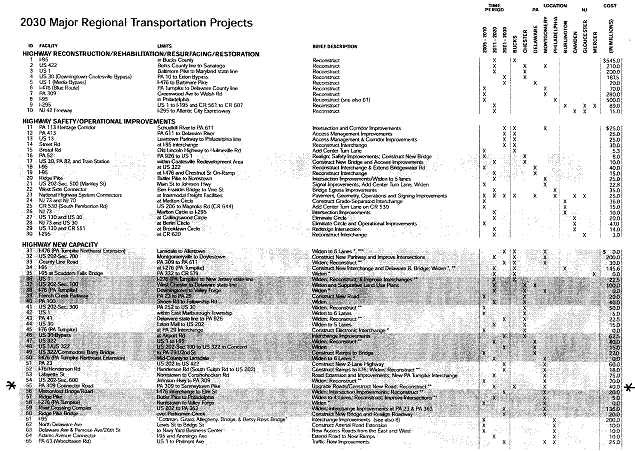The following are project examples that highlight some scenarios where Divisions encountered challenges with fiscal constraint issues with pending, active or concluding NEPA processes. These examples are not included here to suggest that fiscal constraint issues can only be dealt with using the remedies described. Each project will have its own unique context. As a best-practice approach, fiscal constraint issues should be considered throughout the planning and NEPA processes, and if any issues are encountered, they should be considered before the NEPA process is initiated and addressed long before NEPA approval is considered.
Example of securing additional funding from new sources early in NEPA process The ICC is a $2.4 billion project in Maryland, just north of Washington, DC. The project was not in the metropolitan transportation plan (MTP) at the time NEPA was initiated. Early in the process, it was recognized by FHWA and the State Highway Administration that the estimated cost of the project, and competing priorities in the region, would present challenges to demonstrating fiscal constraint by inclusion of the project in the MTP. Early in the NEPA process, a decision was made (for both fiscal and operational reasons) to explore tolling as an aspect of the alternatives being evaluated. The revenues from tolling enabled FHWA and SHA to address the fiscal issues, and the ICC was added successfully to the fiscally constrained MTP, and the ROD signed in May 2006. For more information, contact Marlys Osterhues, 202-366-2052.
Example of using a "phased decision-making" approach to address fiscal constraint issues
It was recognized early on in the NEPA process that the planning requirements regarding fiscal constraint must be satisfied prior to FHWA approving a ROD. Total funding for the entire project would not be available at the time the ROD was to be signed. Because the fiscally-constrained MTP did not contain the entire Preferred Alternative for the Valley Highway project, FHWA and Colorado DOT determined that it was appropriate to identify a phased project implementation process. The Draft and Final EIS discussed a phased implementation approach and presented six logical project phases. Phased implementation was discussed with the public and agencies. FHWA and CDOT identified a set of criteria to be used as guidelines in establishing independent project phases, which included, but were not limited to, logical termini and independent utility, contributing to accomplishing elements of the over all project purpose and need, and fiscal constraint (demonstrated by inclusion in the MTP). The phases of the project were included in the RTP before the ROD was approved in June 2007 on Segments 1 and 2. For more information, contact Keith Moore, 202-366-0524.
Example of consideration of fiscal issues and project phasing in planning studies
The I-83 Master Plan, prepared by the PennDOT in 2003, is a transportation planning study to identify, plan, and program future transportation improvement projects for an 11 mile section of I-83. The entire corridor upgrade is estimated to cost at least $1.5 billion. It was immediately clear that construction could not take place simultaneously on the entire corridor, in part because fiscal constraints would reduce the ability to fully fund all required projects at one time. Upon review and analysis of constructability and safety issues, the corridor was divided into four sections that could be funded through the MPO, advanced through PennDOT's project development process, and designed and constructed independently. Each section has both logical termini and independent utility. The corridor will have four independent (but related) environmental processes. Although a NEPA analysis is currently being conducted for the first phase of the study (I-83 East Shore Section 1 Project), this project provides an example of the consideration of phasing and fiscal constraint issues early, in pre-NEPA planning studies. For more information, contact Spencer Stevens, 202-366-0149.
The following example shows how subsequent phases (subsequent to NEPA) of a regionally significant project were shown in the TIP (and STIP). The project is also included in the Philadelphia area MPO's (DVRPC) MTP. This example also shows construction funding that is outside of the 4-year horizon of the TIP for the project but the TIP still includes it for information purposes in later years. For more information, please contact Spencer Stevens, 202-366-0149.
State Route 309 Project, Pennsylvania Example of subsequent project phases (subsequent to NEPA) included in a STIP/TIP (continues on the next two pages).
Pennsylvania - Highway Program
